Finally — a linear displacement transducer (LDT) that mounts inside a cylinder and doesn’t need to have the piston rod core-drilled. Control Products, Inc. has introduced its SL Series of LDTs that mount completely inside hydraulic cylinders and use linear variable differential transformers (LVDTs) to monitor piston position.
Most in-cylinder LDTs use a 2-piece sensor. The stationary piece protrudes into a passage drilled into the piston rod. The other piece is a magnet or wiper embedded in the piston. In the case of the SL Series, the LDT mounts inside the cylinder’s cap end and has a polymer-coated, stainless-steel cable attached to the face of the piston. The cable’s other end wraps around a spring-loaded spool in the sensor. The assembly works similar to a tape measure: as the piston strokes, the cable winds or unwinds around the spool.
The threaded ID of the spool fits over a core with mating threads. As the piston extends or retracts, its motion causes the cable to rotate the spool, which displaces the core along its axis. The fit between the spool and core is spring-loaded to prevent any backlash. The LVDT measures displacement of the spool and produces a 0- to 5-V DC signal that is directly proportional to the displacement of the piston.
Most other in-cylinder LDTs encase their electronics in a housing that protrudes out from the cylinder body. This exposes the electronics to potential physical damage because they are outside the relatively safe confines of the cylinder envelope. Furthermore, due to its construction and the inherent performance of LVDT technology, the SL Series is much more resistant to shock and vibration than conventional in-cylinder LDTs that have a vulnerable cantilevered beam configuration.
The initial design of the SL Series is offered in sizes to fit cylinders with 3-in. or larger bores and strokes to 48 in. Test data reveal the SL Series exhibits negligible effects from a temperature range of Ð70¡ to 260¡ F, repeated shock of 50 G/6 msec, and aggressive vibration Ñ all benefits inherent to LVDT technology. Design life, rated at a million or more full strokes, has shown to well exceed the typical life between cylinder rebuilds. Resolution is rated ±0.005 in. with ±1% full-scale non-linearity. This combination of performance parameters has led Control Products to target cylinders used in mobile equipment as a key application.
For more details on SL Series LDTs, contact Control Products Inc., East Hanover, N.J., by phone at 973/887-9400, e-mail [email protected], or visit www.cpi-nj.com.


